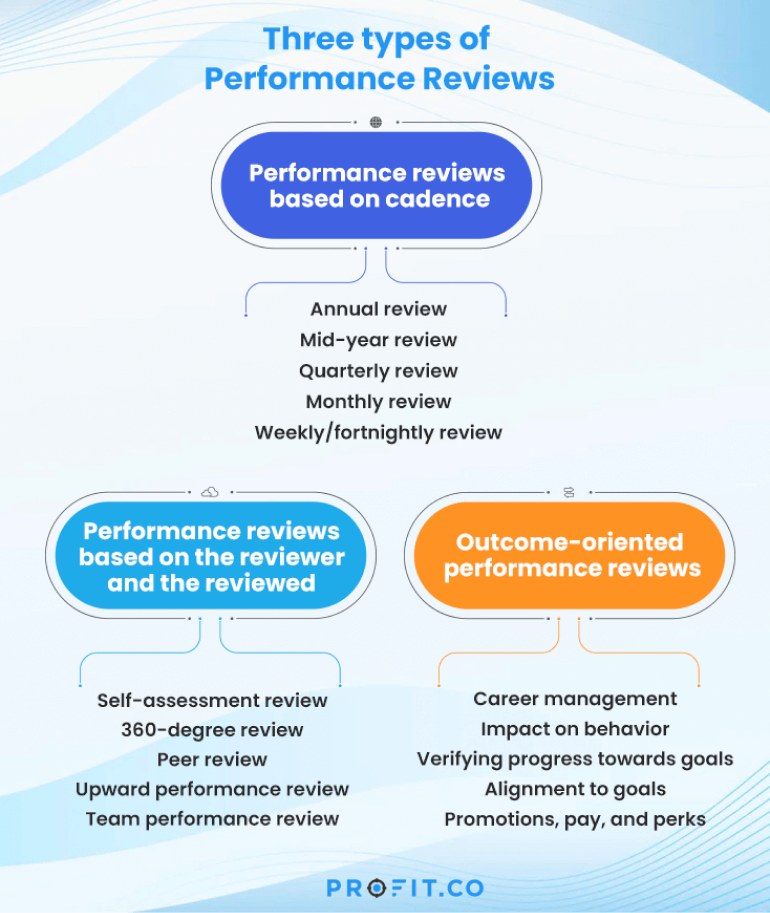The performance management system can be complex and subject to many quirks and idiosyncrasies. One of the critical areas of focus is the type of performance review suitable for your organization. Different performance reviews have been around, and many have evolved over the years. Organizations can choose the kind of performance review and mix and match it to suit the purpose of the evaluation.
Continuous improvement is better than delayed perfection.
What are the three types of performance reviews?
Employee performance reviews vary according to their cadence, those involved in the review, and the purpose of the review.
1. Performance reviews based on cadence
Depending on their cadence, the focus of the review and what the review covers may vary. In a weekly review, it is impossible to assess the performance of employees based on their progress towards their long-term goals. So, the focus of a weekly review can only be on weekly goals and verifying whether the employees are progressing. Similarly, every type of review is different.
Performance reviews based on their cadence can be categorized into:
- Annual review: Annual review is the most common form of performance review. It considers an employee’s performance throughout the year and gives a fair assessment and 360 degree feedback by the end of the year. It takes a lot of time for both the managers and the employees to prepare for an annual review since it must cover a lot of parameters, and the employees have to re-collect their achievements, challenges, and what they did in a year. An annual review comment is beneficial for building an overall picture of how the organization performed in a year, how it can set the way forward, and also create extensive documentation of challenges, innovations, workarounds, best practices, success stories, and lessons learned, etc., for future reference.
- Mid-year performance review: Midyear performance reviews are conducted at the end of one-half year. They provide managers with the flexibility of evaluating the performance of employees in a relatively shorter review period compared to annual reviews. It helps the managers adjust expectations and realign the employees halfway through the year so they can perform better and meet the expectations by the end of the year.
- Quarterly review: Since the operations of an organization are clustered within four quarters in a year, usually, the medium-term goals (quarterly goals) and targets are also set during every quarter. So, it makes sense to evaluate the performance of employees at the end of every quarter, and it provides ample time for employees to improve their performance based on feedback and make progress in subsequent quarters.
- Monthly review: Monthly reviews are relatively short-term reviews that are especially helpful for evaluating the performance and progress of newly hired employees, employees who were newly appointed in a project, or contract employees who are employed for a short period.
- Weekly/fortnightly performance review: Weekly/fortnightly reviews are conducted to evaluate performance during a week, specifically focusing on particular short-term goals/projects rather than measuring the overall performance. These reviews help in quick course correction to guide employees on the right path toward long-term success.
2. Performance reviews based on the reviewer and the reviewed
Employee performance reviews are not necessarily always conducted by managers; sometimes they are performed by peers or other employees. They are conducted so that one person’s biases can be eliminated, compare employees against others with similar responsibilities, bring in a multitude of perspectives regarding an employee’s performance, or evaluate the leadership itself. Employees can also be encouraged to evaluate themselves based on some self-assessment examples. This will prepare them when they go through a review process. Following are some of the performance review methods based on who reviews them.
- Self-assessment review: As the name suggests, self-assessment is a review where the employees assess their own performance. It helps to consider their performance against the benchmarks and recognize their contribution to the organization.
- 360-degree review: 360-degree review eliminates bias and gives a more accurate evaluation of employees’ performance from the point of view of all the other employees with diverse job descriptions. Managers can use the results and engage with the employees by effectively using some of the popular 360-degree feed phrases.
- Peer review: Peer review helps to evaluate an employee’s performance with the benchmarks set by their peers. It helps to compare the performance of employees with similar roles and responsibilities and pushes employees to expand their capabilities and raise their performance to meet the benchmarks.
- Upward performance review: Upward performance review allows the organization to understand and measure the capabilities of the leadership, as it lets employees review their superiors. It enables the organization to measure managerial skills, identify the leaders within the organization and create a culture of open feedback.
- Team performance review: Team performance review takes away the emphasis on the performance of an individual and focuses on how employees work together and perform as a team. It helps to build a picture of the capabilities, strengths and weaknesses, training needs, and goal alignment of an entire team.
3. Outcome-oriented performance reviews
Employee performance reviews can be conducted to achieve specific outcomes. Following are some purposes for which outcome-oriented performance reviews can be performed.
- Career management: Performance reviews are conducted to identify the skill sets of employees required to fulfill the goals and the organization’s overall objectives. These reviews help audit the skill sets, competencies, and capabilities of the workforce and identify suitable training programs for upskilling/reskilling the employees so that they will have a fruitful career and adequate growth within the organization. This ensures job satisfaction and reduces employee turnover.
- Impact on behavior: Performance management starts from the individual, and the behavior of employees at work plays a key role in enhancing performance. For instance, good task management skills, punctuality, ability to prioritize the right tasks at the right time, teamwork, etc., go a long way in ensuring productivity. But these qualities and behaviors need to be nurtured. Performance reviews can be conducted to link performance and productivity to employee behavior and address the gaps by bringing behavioral change.
- Verifying progress towards goals: Weekly reviews, one-on-one meetings, and other informal conversations help to verify the progress towards an employee’s short-term and medium-term goals. These reviews aim to push the employees to meet their goals and seek any support/collaboration needed to complete the goals on time.
- Alignment to goals: Employees’ effort translates into useful performance only when their actions aim to achieve outcomes that fulfill organizational goals. For that, it is essential to ensure that every employee clearly understands their goals and that they align with the organizational objectives. Employee performance reviews can be conducted to verify goal alignment and to realign employees if needed.
- Promotions, pay, and perks: If the employees are not recognized duly on time and are not provided the right compensation, it can lead to dissatisfaction and employee turnover. Performance reviews can be conducted to identify if an employee is ready for promotion or if they deserve a pay hike or more incentives.

Final Thoughts
Organizations have many options before them to peg their performance review process. Sufficient thought and planning are necessary to choose the proper process to suit the organization, employees, and business type. Book a free demo with our team to learn more about how performance management software can optimize your organization’s performance review process!



